From father to sons
In 1979, the time had come for Erik Philip-Sörensen, the founder of Securitas, to step down. Ideologically, Erik was a strong opponent of hereditary privileges and believed it was only fair that his own sons should compete on equal footing with other potential buyers. Fortunately, Erik’s sons, Jörgen and Sven, managed to secure the funds to purchase the company. Subsequently, the trio reached an agreement to split the business into two parts. Jörgen took control of the international operations, which would eventually evolve into G4S, while Sven took charge of the Swedish operations, developing it into what is now known as Securitas.
But the road to success was long and not without its challenges. In the 1970s and 1980s, the security industry suffered from low profitability, driven by inflation and the oil crisis of the 1970s. Severe financial strains kept pushing the company to the brink of collapse. Bank accounts were emptied to keep operations running and salaries paid. Something drastic was needed to mitigate the looming catastrophe.
Taxi service and plant care?
During the 1980s, it became popular among companies to extend their portfolios beyond their core offerings. Driven by volatile markets and changing client preferences, the multiservice model was adopted in several business sectors globally. General Electric ventured into media, ITT into leisure and entertainment, and Volvo into food and pharmaceuticals. Low profitability in the security industry led Securitas to jump on this trend as well, making security services just one part of the company’s broader offering, which then expanded to include taxi service, plant care, and wake-up services.
Venturing far from traditional security services eventually led HR to push away potential job candidates because of the company’s instability. Trying to develop services for everyone meant actually meeting the needs of no one; clients, large and small, began to feel the strain, and so the stage was set for a new era of refining and prioritizing the company's foundational security services.
A turning point for Securitas
In 1983, holding companies Skrinet and Cardo acquired Securitas but quickly encountered financial difficulties, leading to its sale to Gustaf Douglas and Investment AB Latour in 1985. As the founder of Latour, Gustaf Douglas (1938-2023) was instrumental in creating the modern Securitas. Under his tenure as chairman, he supported Securitas to grow substantially and start the international expansion. Gustaf was a firm believer in strong core values, and thanks to him, Securitas has provided a values-driven work environment for millions of colleagues.
In searching for a new leader for Securitas, Gustaf landed on the ideal candidate. Melker Schörling (1947-2023) grew up in a farming family in a small village in middle Sweden. Looking back at his career, his profound interest in people and business forged a remarkable journey. One of the keys to Melker’s success was his exceptional ability to identify the right leader for the right company.
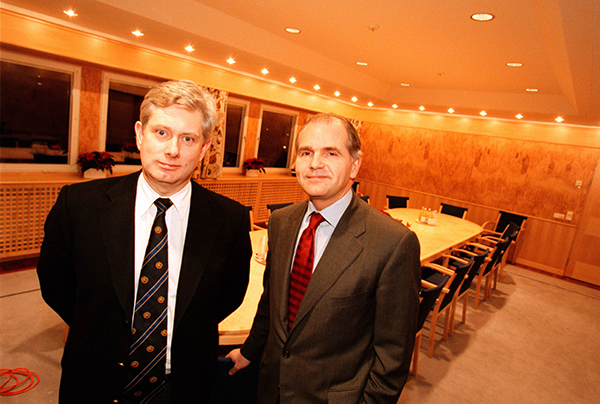
Thomas Berglund and Melker Schörling in the board room at Securitas HQ in Stockholm in 1988. Photo: Stefan Borgius, TT Nyhetsbyrån
Melker’s arrival marked a turning point for the company. He recruited Thomas Berglund (CEO 1992-2005) and Carl-Henric Svanberg (President of the Alarm Division and ASSA 1986-1994), and Securitas seemed to be on the path to success once again. Schörling instilled within the organization a leadership philosophy emphasizing the development of people as allies in service-oriented businesses, alongside a focus on simplicity and clear communication, fundamentally transforming the company’s culture.
By 1987, amidst various multiservice propositions, a consensus emerged that Securitas should focus on its core business. The mantra, "security is good enough," was adopted – a stance that resonated across the company. This shift entailed a series of realignments, assessing clients, organizational structure, and financial health. True to the ethos of a leading service provider, the clients’ needs were prioritized. This period underscored a crucial lesson: Focus is not only about what to do but also about what not to do.
Clear and simple organization
In 1987, Securitas started restructuring for simplicity. Previously, each market operated semi-independently with its own leadership, often branching out into different services. The new approach brought regional leaders directly under Melker’s leadership, sharpening their focus on security services. This shift encouraged a decentralized model where regional branches had the freedom to tailor security solutions to the needs of their clients, fostering a stronger client connection and maintaining a flat organizational structure that kept the company nimble and responsive.
This change empowered branch managers and frontline staff, giving them the autonomy to excel in their roles with minimal central oversight, thereby promoting entrepreneurship and accountability. The transformation led to a significant increase in branch managers, from five individuals overseeing national operations to 130 managers, each responsible for their local unit's success, streamlining the headquarters to a lighthouse rather than a control tower.
This story charts Securitas' rough ride in the 1980s, but just like after every storm, brighter days were ahead. With a firm direction and clear focus, the company was set for a new era of growth and leadership in security.
![]()
Melker's vision leading to client-centric success
In a meeting in the late 1980s, Melker wanted to highlight the company’s progress and what he envisioned for the future. He grabbed a marker and drew a horizontal line on a projector screen to depict the business’ current state; at the end, he added a 45-degree ascending line. But in his ambition to demonstrate the need for growth, he did not realize that he had drawn the line using a permanent marker! What was just meant to be a temporary illustration became a constant reminder to execute and improve, reflecting the commitment that would shape Securitas for years to come.
Securitas had survived the most turbulent times in the company’s history, which culminated in a restructuring in the mid-1980s. Now that the company had new owners and a new management team, it was time for a strategic shift. With a clear vision and focus, Securitas was ready for a new chapter of growth and leadership, acknowledging that success could only be achieved by happy clients.
Creating value through segmentation
To better serve clients, the management team spent weeks re-evaluating how they were segmented. This effort laid the groundwork for what would become Securitas' renowned Market Matrix, in which all clients were divided into several segments. However, the matrix became a massive document, making it challenging to use as a tool.
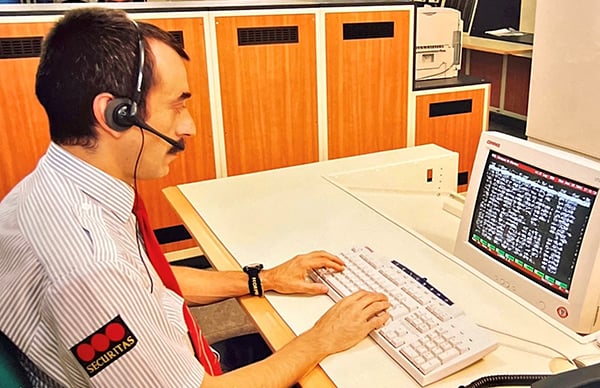
Securitas employee in an alarm center in Portugal, late 1980s. Photo: Securitas
Melker proposed simplifying segmentation into three primary groups: large enterprises, small businesses, and banks. This decision marked a shift toward prioritizing client needs, enhancing market knowledge, and adding value through tailored services.
Negotiations with clients often centered around price rather than quality or service. To combat this, the strategy shifted toward adding greater value for clients, moving the conversation from merely the hours billed to the solutions provided.
Securitas could achieve a higher profit margin by delivering solutions that add value rather than merely more hours. A higher margin would lead to better wages for officers. Better-paid officers could be upskilled and work more effectively, thus contributing to the further development of our services. In short, it created a domino effect that would help prevent the negative spiral of decreased prices, wage pressure, and high staff turnover.
Commitment and leadership
Securitas' increased focus on clients could not have taken place without Melker’s analytical, motivational, and diligent leadership style. His meticulous ability to identify what’s important – which earned him the nickname "Mold Dog" – ensured that no problem was left unaddressed. Somewhat famously, he insisted that no one leave meetings until a problem had been solved. While this rule no longer exists (perhaps thankfully!), this steadfast commitment to problem-solving remains in our DNA today.
Besides Melker, the leadership team at Securitas in the early 1980s consisted of Thomas Berglund, Carl-Henric Svanberg, and Håkan Winberg, author of the first-hand account of Securitas’ history, Approximately Right: Aligning Your Numbers with Your Business (2016). In this book, Thomas summarized the Securitas way quite elegantly: "You build culture from the top-down and build the organization from the bottom-up."
![]()
Expanding borders and markets
After a tough start in the 1980s, the future was looking bright for Securitas. The new management team invested heavily in restructuring the organization and offering the best possible solutions to get closer to the end client, and the winds of change were now blowing in the right direction.
In 1989, the winds carried Securitas to Denmark, Norway, and Portugal, where Securitas would begin its international expansion through key acquisitions. While each was significant in its own right, the Portugal acquisition was particularly special. It might have seemed like a bold move due to the substantial geographic and cultural differences between Sweden and Portugal, but it was, in fact, a carefully planned and strategic decision. The business in Portugal was owned by G4S – Securitas’ previous sister company, which was established by Jörgen Philip-Sörensen after the Securitas split in 1981 – making the acquisition somewhat of a reunion of two “related” businesses.
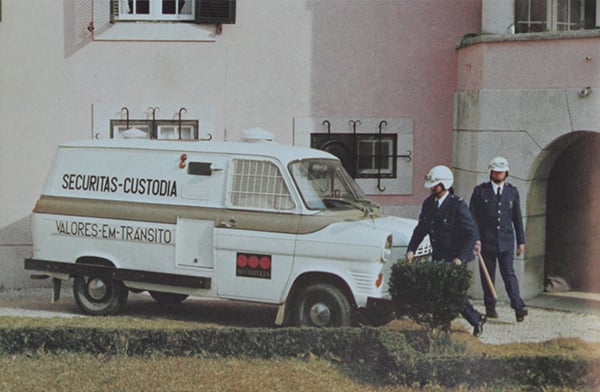
Cash-in-transit vehicle from Portuguese Securitas-Custodia in Lisbon, Portugal. Photo: Securitas
Navigating international workplace cultures and customs offered valuable lessons for Securitas – one of which stemmed from the practices related to the timing of invoice payments. With the company’s presence and geographic footprint expanding, it became even more crucial to manage timely payments effectively. Consequently, the company focused on reducing the number of outstanding accounts receivable days, which eventually became the sixth key factor in the Securitas financial model – turning the Five Fingers approach to Six Fingers. The fingers refer to crucial areas upon which Securitas should measure performance, such as total sales and gross margin. This positive outcome underscored the importance of smooth integration in acquisitions, shaping Securitas' acquisition strategy for the future.
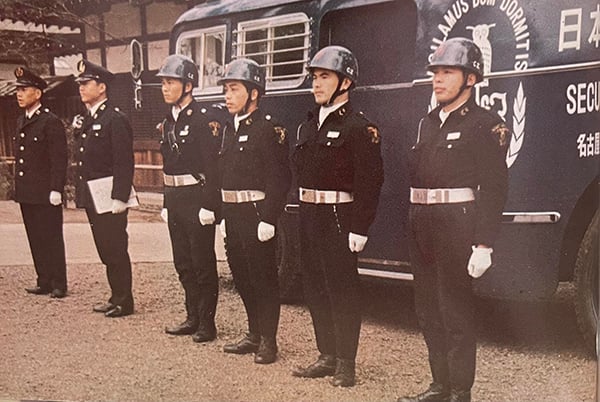
Erik Philip-Sörensen’s venture in Japan was an early example of internationalization
Securitas’ internationalization and growth strategy
Acquisitions have become vital to Securitas' growth strategy, proving effective for entering and gaining a leading position within new geographic markets and market segments. Moreover, acquisitions have allowed Securitas to restructure and consolidate a fragmented industry, transforming smaller players into larger, more resourceful entities capable of taking active responsibility for the industry's progress. This approach was pioneered by Securitas’ founder, Erik Philip-Sörensen, who, in the early days in Sweden, acquired local companies and integrated them into one large organization. One early example of an international venture took place in Japan.
After a failed venture in Hong Kong in the early 1960s, Erik started a security company in Japan. Erik wanted the best people and recruited the company’s first officers from Malmö, Sweden, some 9,000 kilometers from Tokyo. The breakthrough for the new Swedish-Japanese company came when it was awarded the security contract for the 1964 Summer Olympics in Tokyo. Coincidentally, Japan’s largest commercial television company launched an action television show about security guards. Thanks to Erik's pioneering efforts in the Japanese security industry, the officers in the TV show were dressed in Swedish uniforms and featured Securitas' logo on their cars! The Japanese company's shares were later listed on the Tokyo Stock Exchange, with Securitas as a minority owner.
Since the first expansion beyond Sweden's borders, Securitas has successfully completed numerous acquisitions. From experience, rapid integration yields positive results in volume, margins, and profitability. A key component of this strategy involves maintaining a balanced position in each market to align with industry standards and manage wage levels effectively.
The bigger the pie, the better for everyone
As economies around the world grew, Securitas chose to adopt a broader perspective. Instead of solely competing for market share with competitors, the company aimed to expand the entire security market. Securitas believed that expanding the market itself was more advantageous than simply growing its own business. Doing so created the opportunity to secure larger “slices” from a growing pie rather than from the existing pie.
The growth strategy was driven by Securitas’ specialization and nuanced understanding of the diverse needs of its clients, coupled with continuous improvements in the quality of officers and services. An important part of this strategy was increasing wages, which made the profession of a security officer more attractive and accessible to a broader pool of candidates. These improvements not only propelled the company’s own growth but also stimulated growth across the entire security industry.
Divestment: A different kind of growth
However, not all growth came from acquisitions. In 1988, Securitas acquired Assa Abloy, a leading lock manufacturer, integrating it into the security portfolio. However, by 1994, recognizing the operational and cultural differences between the manufacturing and service sectors, Securitas distributed Assa Abloy back to its shareholders.
This decision not only refocused the company’s efforts on its primary security services but also proved financially astute, as the transfer of Assa Abloy generated a substantial dividend. Additionally, it allowed Assa Abloy to thrive independently, increasing its market value significantly and demonstrating the long-term benefits of Securitas’ approach to focusing on core competencies.
From 4 to 14 countries across Europe
Following the divestment of Assa Abloy, Securitas began its rapid expansion across Europe – expanding its presence from four to 14 countries in just seven years. This started with the acquisitions of guarding companies in Austria and Switzerland, and then Securitas took a bold step in Spain by acquiring a bankrupt business along with all of G4S' local operations. Expansion continued swiftly into the UK, Finland, France, and Germany.
In 1998, a pivotal moment occurred during a conference in Stockholm aptly themed "Dreams Come True." At this event, Securitas managed to acquire two major companies in France and Germany, significantly boosting its footprint across Europe. By then, Securitas could proudly claim coverage across most of the continent.
This rapid expansion was always grounded in the company’s core values, with a strong focus on security and financial oversight. Håkan Winberg, the CFO at the time, explained the approach by saying that the company didn’t take financial risks; it embraced business risks by expanding quickly. The strategy integrated diverse business cultures and languages, demonstrating unity through shared values despite language barriers. Adherence to these values was essential and critical for expansion.
Introducing divisions with focused specializations
In 2001, Securitas launched a structural reorganization to transform its operations into international divisions for each distinct business function. Previously structured as nation-based companies – such as Securitas Sweden, Securitas Norway, etc. – where each entity managed various security services like home alarms, guarding, and cash handling, the reorganization created specialized international divisions. This change led to the establishment of a unified global division for cash handling and, similarly, for home alarms; the guarding services were split into Securitas Europe and Securitas USA.
This strategic shift was crucial, as it allowed each division to achieve deep specialization in its respective field, positioning it as a global leader in that particular area. By creating five international divisions instead of maintaining 34 national companies, Securitas could refine its service offering and develop deep specializations in different areas.
As Håkan Winberg highlights in his book Approximately Right: "Instead of having a kind of ambassador in a country trying to understand a bit about all these different customers and segments, we had people running the business who understood that business from top to bottom."
![]()
Strategic acquisitions: Uniting legendary brands
At a management conference in Barcelona in 1999, a daring goal was unveiled: to double Securitas' turnover within just six months. Despite the company's notable growth in recent years, the bold ambition was initially met with skepticism. However, when the announcement of the acquisition of Pinkerton was made, the skepticism turned to immediate enthusiasm.
Founded in 1850, Pinkerton was the first detective agency in the United States and a legendary name in security, known for protecting Abraham Lincoln. But this major acquisition wasn’t all. In 2000, Securitas acquired Burns (founded in 1909 as William J. Burns International Detective Agency), another North American crown jewel with a rich history.
Securitas’ foundation in Europe was already strong after the expansion in the mid-1990s. The two major U.S. acquisitions represented a significant expansion for Securitas and demonstrated the company's ongoing journey to continue to improve the security industry – this time across the Atlantic.
Along with other regional acquisitions, Pinkerton and Burns solidified Securitas' position as a market leader in both Europe and the United States. By 2001, sales had increased to 74 billion kronor, up from 31 billion kronor in 1999. The integration of Pinkerton and Burns, each with its storied past, heralded a new era for Securitas, positioning the company as a global powerhouse in the security industry.
A physical toolbox
After acquiring major U.S. companies, Securitas realized the need for clearer management training to enhance the understanding of company culture and strategy across the Atlantic. Managers in the U.S. found the training foreign, not fully grasping its content.
This prompted Securitas to transform its “Toolbox” from a concept to a physical object – a set of wooden tools representing the company’s management principles. At the Securitas 2000 Barcelona conference, 1,000 wooden Toolboxes were given to managers, with each box symbolizing the company’s goals and culture. The scene at the airport was truly unforgettable, with everyone proudly carrying their bulky new tools, creating a fun and memorable moment
Until hell freezes over
Despite the ambitious expansions, Securitas' journey to the United States was not without its challenges. The transition brought about a period of negotiation with American trade unions. Securitas enjoyed a cordial relationship with European unions, a rapport that extended to the service industry unions in the U.S., led at the time by Andy Stern, the president of the Service Employees International Union. Stern wanted assurances for the industry's workers and sent letters to Securitas that demanded action to address what he saw as significant issues.
In an effort to maintain peace, Securitas encouraged its European union contacts to reach out to Stern to affirm the company's commitment to fair and responsible practices. This led to a brief period of calm, but it did not last. Tensions rose. In response to the growing conflict, CEO Thomas Berglund took the first flight to Chicago. There, in a highly publicized meeting with media and union representatives from both the U.S. and Europe in attendance, Thomas laid out the options: come to the negotiation table to find a resolution or prepare for a standoff "until hell freezes over."
A bold move to specialize even further
Five years following the establishment of its international divisions, Securitas took a decisive step in 2006 by giving three of its subsidiaries, Securitas Security Systems (electronic security, later known as Niscayah), Securitas Direct (home alarms), and eventually, in 2008, Loomis (cash handling) back to its shareholders. According to business media at the time, it was quite a controversial step.
As the world favored increasingly complex structures for the production and supply of goods and services on a global scale, the move was in line with what was driving society forward. Independence meant that each company could focus more directly on advancing its specific segment. This structure empowered leaders at all levels of these companies to drive their operations forward without the constraints of a larger group.
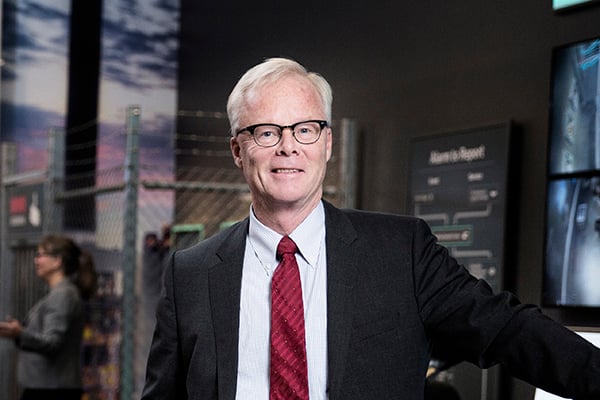
Alf Göransson, CEO and President 2006-2017. Photo: Ingemar Lindevall
The decision to spin off these entities was announced on February 9, 2006, through a press release titled, "Securitas to list three new specialized security companies on the Stockholm Stock Exchange." The potential of each business to succeed independently was evident and expected to contribute significantly to Securitas' bottom line in the ensuing years. The strategy was a pure form of specialization, anticipating that each division would continue to grow and profit, stay ahead of the market, and innovate within their respective industries.
While many companies consider divesting parts of their business only as a last resort, Securitas proactively chose to distribute these divisions to its shareholders after considerable thought and debate. Much like the nurturing of Assa Abloy, this move demonstrated that Securitas had effectively developed three robust businesses capable of thriving independently.
Financial crisis
On March 5, 2007, Alf Göransson succeeded Thomas Berglund as the new CEO and President of Securitas, taking over during the midst of the spinoff of Securitas Security Systems, Securitas Direct, and Loomis. When this mission was completed, something happened that would throw the world into turmoil.
Lehman Brothers' collapse in 2008 triggered a stock market crash, putting the entire financial system at risk. Clients faced business declines and initiated immediate cost-cutting efforts. As a response, Securitas prioritized portfolio protection, customer support, and strategic acquisitions at what had become favorable prices. Despite the crisis, Securitas managed to maintain its portfolio, with only a 1 percent loss from 2009 to 2010. Between 2009 and 2011, Securitas completed 49 acquisitions, adding 58,000 new colleagues.
Solving the security equation
Like other businesses, Securitas faced challenges as operating margins dropped due to price pressures. Simultaneously, however, the company made significant investments in technology and security solutions, despite stagnant top-line growth. To boost shareholder value, the focus was on enhancing offerings by optimizing the "security equation" – balancing physical security with remote guarding technologies. This strategy involved hiring engineers and building expertise both organically and through acquisitions, necessitating increased investment despite flat revenue and declining margins.
The new strategy was presented to the board, chaired by Melker Schörling. It was acknowledged that, while the transition to a technology-focused approach would be challenging in the short term, it was a strategic move to secure long-term success. With the steadfast support of the board and main shareholders, Securitas weathered the storm.
The hardest-working M&A department
The importance of serving global clients on a worldwide scale became increasingly important due to a more globalized business environment. To retain clients, it was imperative to provide seamless, high-quality services. American clients played an important role in these efforts. Their high expectations and demands for international service capabilities pushed Securitas to serve them across borders.
As a result of serving clients worldwide, Securitas was, at its peak, present in 58 countries. Financial Times once described Securitas’ M&A department as “the hardest-working M&A department in the world.” The acquisition strategy was closely aligned with clients’ needs. It also ensured that any company considered for acquisition was not only a good fit in terms of business and geographical location but compatible with the corporate culture as well. This evaluation became a crucial part of the due diligence process, resulting in only pursuing acquisitions that aligned with Securitas’ values.
Big data and risk prediction paving the way
Starting in 2013, Securitas began to experience consistent growth, affirming the strength of its strategic choices as it outpaced the overall security market. During this time, Securitas experienced the highest earnings per share in company history for three consecutive years.
Securitas started to invest in big data technologies to enhance risk assessment and prediction capabilities, solidifying the position as a global leader in the security industry and paving the way for the future Securitas. Under Alf’s leadership, Securitas doubled turnover, tripled profits, and nearly doubled its employee count, a growth driven by a shift towards technology and acquisitions, solidifying Securitas as a global security leader.
Except where indicated, the photograph is taken from the book Vakt av värde by Sten Söderberg (1979). Photographer unknown. If you own the rights, please contact press@securitas.com.







